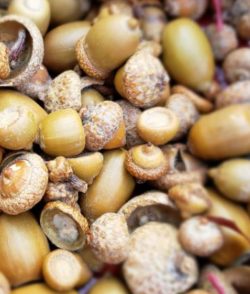
Tree Anatomy: Nuts
At this time of year, trees across the Willamette Valley are producing a bounty of nuts. Nuts are one of the many seed adaptations of trees. The botanical definition of a nut is a dry fruit with only one seed. The seed of a true nut does not split open at maturity. Chestnuts, hazelnuts, and acorns are examples of true nuts.
Most people consider walnuts, pecans, and almonds to be nuts, also, but they are actually the seeds of drupes. A drupe, like a peach or cherry, has a fleshy fruit that surrounds a hard pit with a seed inside. The edible part of the walnuts, pecans, and almonds is the seed inside the pit.
The outer shell of a true nut is the ripened ovary wall, called the pericarp. Inside the nut are the embryonic root and stem of a future tree. The nuts are full of food to sustain a seedling until it can grow its own leaves and make its own food through photosynthesis.

The nut of the oak tree, called the acorn, is made up of the cap, the tough outer shell, and the kernel inside. The tough outer shell and the cap of the acorn, called the cupule, protect the seed. The kernel is made of two fatty seed leaves, called cotyledons, which surround a small embryo in the pointed tip of the nut. Depending on the species, acorn nuts require anywhere from six months to two years to mature. Over a hundred animal species, including squirrels, rely on the acorns as an important food source. Some animals bury the acorns to store them for the winter. Not all of the buried acorns are dug up and some of them germinate and grow into mighty oak trees.
Only some nuts are edible by humans. One of our favorite edible true nuts, the hazelnut (also known as the filbert), grows on filbert trees and achieves culinary perfection in Oregon. The perfect combination of soil and climate make the Willamette Valley a world-renowned hazelnut growing center. Oregon grows 99% of the hazelnuts grown in the United States. For some hazelnut recipes from the experts, check out the Oregon Hazelnut website.


